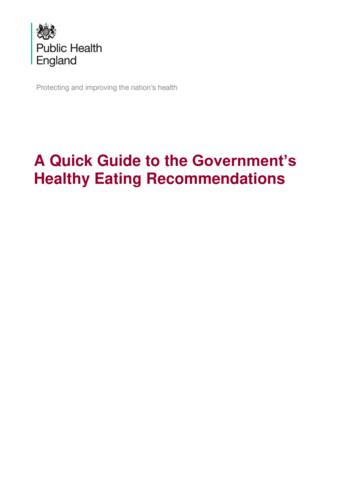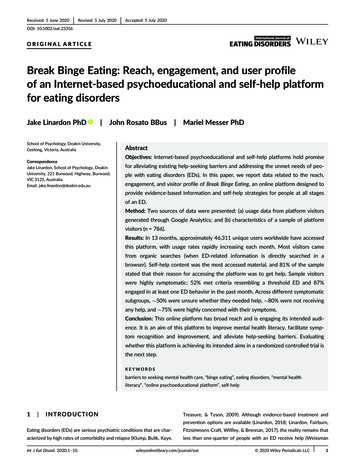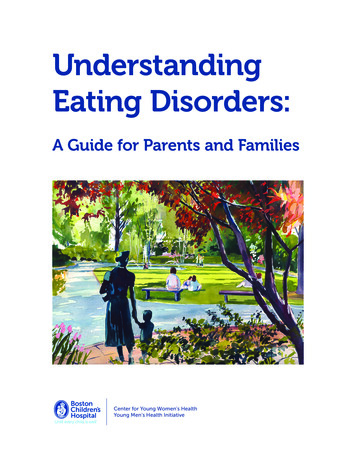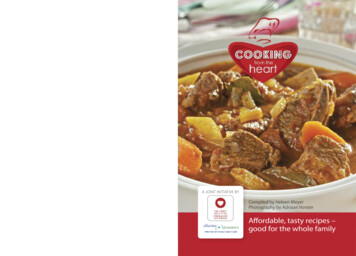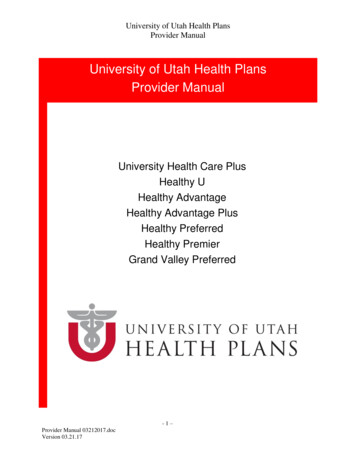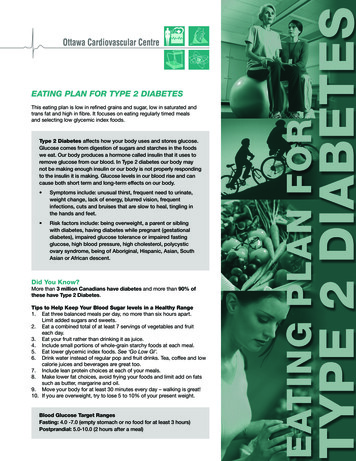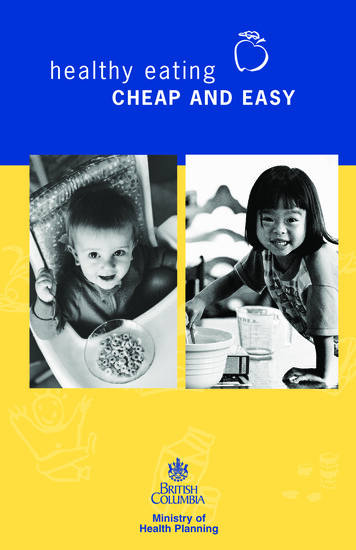
Transcription
healthy eatingCHEAP AND E A S YMinistry ofHealth Planning
healthy eatingCHEAP AND EASYEating healthy foods is one of the best things you can do foryourself and your family every day. When you eat well, you feelbetter. You have more energy. And you lower your risk of heartdisease, diabetes and some types of cancer.Many healthy foods like breads, cereals, fruits and vegetables cost lessthan other foods like chips and pop. So you can eat well withoutspending a lot of money or a lot of time.That’s what this booklet is about. It covers the basics of planningmeals, shopping and preparing foods. It also lists some places in yourcommunity that can help you save time and money on food, and tellsyou where you can find recipes for healthy meals.For more informationon healthy eating,call 1-800-667-DIET(732-9191 in theLower Mainland) andtalk to a dietitian.There's no chargefor the call.
childrenNEED HEALTHY FOODhealthy eatingdoesn’t meanforcing kids toeat things theyEating well means getting enough foodsfrom all four food groups:grain products (breads and cereals)don't like, orvegetables and fruitmaking them eatmilk and milk products like milk,cheese and yogurt, andeverything ontheir plate. Theimportant thingmeats and alternatives like chicken,fish, nuts, beans and peanut butter.You can help your children eat well by:is to feed themsetting a good examplewell, and helpeating healthy foods more oftenthem learn aboutoffering meals and snacks at regulartimes, andhealthy choices,so they can dothe same thingfor their kids.2Children need the right foods to growand to stay healthy. They also need youto teach them how to eat well.giving your kids a variety of foods atmeals and snacks.
planning mealsOne of the best ways to make sureyou eat well is to plan your mealsahead of time. Planning aheadcan help you:get enough of all fourfood groupsadd variety, so you’renot eating the samethings day after daysave money by buying only whatyou needuse up foods that you already have on hand, andsave time by shopping less often.Planning is also a good way to get your kids involved in learning abouthealthy foods and making the right choices. Plus, they’re more likelyto enjoy eating foods they pick out themselves.get your kidsinvolved in learning abouthealthy foods, making theright choices and helpingwith food preparation safely.3
budget tipsFOR PLANNING MEALSThink about healthy recipes you like.Look at grocery flyers and newspaper ads and plansome of your meals around things you like that are onsale, or seasonally less expensive.Build the main part of your meal from rice, noodles orother grains.Choose whole grain products more often. Use small amountsof meat, poultry, fish or eggs, and make sure you include somevegetables. For example, you can make a healthy casserole bymixing rice, vegetables and a small amount of meat or beans.Add grated cheese and you have all the food groups covered!Add variety by trying new recipes.For example, if you normally make mashed potatoes, try bakingthem or making potato salad instead. It’s a good way to makeyour family’s meals more interesting.Save timeand moneyby planningfor leftovers.4
Save time and money by planning for leftovers.For example, if you’re cooking chicken on Monday, plan touse the leftovers in a stir fry, a casserole or in sandwiches onTuesday. You can also freeze leftover meats and use them laterin soups or stews.When you have extra time, cook in larger batches.If you find ground beef on sale and can afford the extra cost,make an extra big pot of chili or spaghetti sauce. Have some fordinner one night and divide the rest into meal-sized portionsto freeze for later. Save large yogurt and margarine containersfor freezing meals.Plan for healthy snacks as well as healthy meals.Fresh fruits in season, raw vegetables, cheese, popcorn, crackersand whole wheat bread all make good, healthy snacks. They’realso more affordable than candy or potato chips.Plan for school lunches. Think of things to pack.Include fruits such as apples and bananas and vegetables likecelery or carrots and other produce in season. Dinner leftovers(like pizzas and burritos) also make easy lunches. Pack them upand put them in the fridge when you’re clearing up the kitchenin the evening.For information about what produce is available seasonally,check out the Availabilty Chart at the Canadian ProduceMarketing Association web site:http://www.cpma.ca/english/hns/avail.html5
shopping.before you goMake a list of all the foods you need. Do this in your kitchen soyou can check what you have on hand.Ask your kids. For example, if you’re planning to buy greenvegetables, ask them what they’d like best. Broccoli, peas, greenbeans, spinach, lettuce, celery or cabbage? Give them a choice.Look for grocery sales in flyers and newspaper ads for the storeswhere you shop.Save coupons for the foods you plan to buy. But make sure youcheck other prices, too. Coupons don’t always give you the best deal.Usually "no-name" brands are cheaper.Ask your kids whatthey’d like best.Have a good meal or ahealthy snack before yougo. If you shop when you’rehungry, you might betempted to buy foods youdon’t need.Broccoli, peas, greenbeans, spinach,lettuce, celery orcabbage? Give thema choice.6Find out about foodbuying clubs, cooperatives,and farmers' markets. Checkyour community newspaper orcall the nutritionist at the publichealth unit.
shopping.while you’re at the storeAsk about becoming a member for price deals. Ask about freedelivery.Keep to the outside edges of the store. That's where most of thefresh food is found.Whenever you can, stock up on healthy, low-cost foods thatkeep well. These include rice, potatoes, noodles and frozenorange juice. Watch for case-lot sales.Stick to basics instead of prepared foods like frozen packagedmeals and vegetables in sauces. Prepared foods may save youtime but they cost a lot more.Try no-name labels or store brands. They are just as healthybut cost less.Buy fresh fruits and vegetables in season. Look for ones that arelocally grown. They are fresher and usually cost less.Don’t be fooled by big displays. Signsdon’t always mean there’s a special price.Buy only as much as you need of foodsthat can go bad. Otherwise it is a wasteof money.Choose foods that pack well for schoollunches.7
tipsFOR PRODUCT INFORMATIONCompare prices on similar items.Look for the ‘unit cost.’ It shows you how much something costs(usually per 100 grams) so you can tell which size or brand isthe best deal. Many stores show the unit price on the shelf belowthe product.Tomatoes794 mL 1.69 21.3 /100mLTomatoes540 mL 1.09 20.2 /100mLLook for ‘best before’ dates furthest away to help you buy thefreshest foods.Read the nutrition labels on packages. This can help you choosefoods that are lower in fat and have more vitamins, mineralsand fibre.Avoid foods that contain a lot of sugars. And remember, theydon't always call it sugar or syrup. Glucose, fructose and otherwords that end with ‘ose’ mean sugar.Remember. glucose, fructoseand other words that end in ‘ose’mean sugar.8
tipsFOR SMART SHOPPINGGRAIN PRODUCTSLook for bargains on day-old bread andbakery products.Buy plain rice, oatmeal and pastainstead of the instant andflavoured kinds. Add your ownflavourings such ascinnamon or applesauceto oatmeal.Avoid fancy pasta shapes.They cost more thanspaghetti or macaroni.Buy grains, pasta and cereals in bulk and stock upwhen they’re on sale.Try brown rice and whole grain breads and cereals to make yourmeals healthier and more interesting.MILK AND MILK PRODUCTSBuy fresh milk, cheese and yogurt in the largestsize you can use.Buy skim or 1% milk – except for childrenunder the age of two. They should havewhole milk.Avoid prepared products like gratedcheese, cheese strings and yogurt in tubes.They cost a lot more.9
VEGETABLES AND FRUITBuy fresh fruits and vegetables when they are in season.Don’t buy mushy fruits or vegetables. Pick firm ones.Buy small pieces of fruit to avoid waste.Buy frozen fruit juice. It’s cheaper and keeps longer in thefreezer.Buy 100% fruit juice. Fruit drinks and fruit punch are mostlysugar and water.If you buy canned fruit, pick a kind that’s packed in water orunsweetened juice instead of sugary syrup. Read the label.Buy large bags of frozen vegetables. Cook what you need andkeep the rest in the freezer.Avoid buying frozen vegetables with sauces or flavours added.They cost a lot more. Add your own seasoning or sauceAvoid buying prepared raw vegetables like carrot and celerysticks. They cost a lot more. Buy them whole, and cut your own.Buy fresh fruitsand vegetableswhen they are inseason.10
MEAT AND ALTERNATIVESAvoid buying meats that come with sauces, stuffing orflavourings. They cost more.Compare meat prices based on the number of servings you get.For example, a kilogram of beef short ribs serves two. But akilogram of ground beef can serve up to 10 people.Buy chicken backs and necks. They are very cheap to buy,and give you enough meat for a big soup or stew.Buy plain frozen fish instead of the kind with batter.Stock up on dry or canned beans, peas and lentils when youcan. They give you the same food value as meat – at a muchlower cost, and have less fat. They keep for about a year.Instead of buying stewing beef, buy a cheap steak such as roundsteak and cut it up yourself.Buy plainfrozen fishinstead ofthe kindwith batter.11
tipsFOR HEALTHY COOKINGGo easy on fat, salt and sugar. You don’t have to leave themout, just use less.Cook vegetables so that they remain firm or serve them raw.Don't overcook them.Bake, broil, roast or steam your food. Avoid frying.Always cook ground beef to brown it and drain off the fat beforeadding other ingredients.Use herbs and spices for flavouring. They’re less expensive,quicker, and better for you than rich sauces or gravies.Serve fruit for dessert. You can add yogurt or ice cream. Ormake a fruit crisp by putting oatmeal and sugar on top of slicedapples or peaches and baking them in the oven.Take the skin off chicken or turkey before you cook it. That wayyou eat less fat.Save the water from boiled vegetables and use it for soups orstews.Ask for help if you need it. Advice from family, friends, yourlocal neighbourhood house or the nutritionist at your localhealth unit can help make cooking easier and more fun.Use meat as a side dish,instead of a main course.12
tipsFOR FOOD SAFETYWash your hands with soap and warm running water before youhandle food.Use hot, soapy water to clean cutting boards, knives andanything else that touches meat.Wash the countertop, cutting board or plate used for raw meatsbefore using it again. Spray with a bleach mixture* and rinse.Regularly wash dish cloths and towels with hot, soapy water.Thaw frozen foods in the fridge or microwave, not on thecounter or "thaw" pads. Foods thawed in the mocrowave needto be cooked right away.Cook meat and poultry well. Juices run clear when well cooked.Cook fish until it flakes with a fork.Put leftovers in the fridge right away.Never reheat leftovers more than once.Throw away mouldy foods such as bread and cheese. These arenot safe to eat.*Bleach Mixture:Combine 1 litrewater and 5mLchlorine bleach ina spray bottle13
menu checkMINIMUM NUMBEROF SERVINGSBREAKFASTfruit – 1grain product (breads& cereals – 1milk product – 1LUNCH OR DINNERSNACKS– FROM AT LEAST2 FOOD GROUPSgrain product – 2e.g.:meat & alternatives – 1 carrot sticks &vegetables & fruit – 2milk product – 1plain yogurt dip oatmeal cookies & juice Cheese & crackers14
one dishMEALSVegetablesMeat and meatalternativesLiquidingredientsGrain productsAbout 11 2 cups11 2 to 2 cups1 to 11 2 cups1 to 11 2 cupsmixed vegetablestuna fishtomatoescanned meatcorncooked meat: chicken hamburger lean sausage pork turkeygreen beanscooked andcubed: squash zucchini potatoescream soups: broccoli celery chicken mushroombread, cubedcheese soupcooked spaghettitomato soupcooked noodlestomato soupcooked barleycooked bulgarcooked lentilsshredded cheeseplus milkcooked split peasevaporated milkcooked ricecooked macaronihard cooked eggsbroccolipeascabbagecooked navy,pinto or otherbeans1) Choose one or more ingredient(s) from each list above2) If you like, add other optional flavour: onions, spices, herbs.3) Mix ingredients together.4) Bake: place ingredients in a covered casserole dish. Add optionaltoppings: bread crumbs, craker crumbs, parmesan cheese. Bake at 3500for 45 minutes. Uncover last 15 minutes to brown topping. Serve hot.Or cook in large skillet on top of stove. Simmer till bubbly. Serve hot.15
food ideasMost families have a few favourite recipes that they make again andagain. Here are some ideas for making the basics more interesting, andmore nutritious.replace half the white flour in any recipe with whole wheat flourdouble the beans in your chili, and use half as much meatadd canned tomatoes to macaroni and cheeseadd tuna or celery to macaroni and cheeseadd fresh or frozen vegetables to packaged noodle soupadd frozen corn or leftover cooked vegetables to chili, soup or stewadd raisins or other dried fruits to cookies or muffinsadd raisins, grated carrot or canned pineapple chunks to gratedcabbage to make a salad.cook twice as much rice or pasta as you need. Use leftovers incooking or freeze.Slightly thaw frozen fruit, add milk and sugar, and mix with anelectric mixer or blender (tastes like ice cream but costs less andhas less fat).16
finding more ideasBOOKSPhone your library to ask for "budget"or "low cost" recipe books such as:Eat Well for Less, by TheCorporation of the District ofBurnaby100 Meals Under a Loonie perServing, by Nanaimo Community KitchensThe New Thrifty Kitchen, by the Surrey Food Bank Advisory CouncilMany Hands: Community Kitchens Share Their Best (Recipes)by Community Kitchens PublishingAlso look for books on healthy eating at used book stores and thrift shops.Contact the nutritionist at the health unit for local resources.WEB SITES(you can use a computer at most public libraries)Vegetables and Fruit Campaignwww.5to10aday.comDietitians of Canadawww.dietitians.ca/Dial-a-Dietitian Society of BCwww.dialadietitian.org/BC VegetableMarketing Commission – recipesusing seasonal B.C. vegetableswww.bcveg.comBC Tree Fruitswww.bctree.comBC Dairy Foundationwww.bcdf.orgShop Smart! Food Tipswww.consumer.ca/pdf/food.pdf17
communitynutrition resourcesThere are many ways you can work with other people in yourcommunity to save time and money on food. The nutritionist atyour local health unit is a good contact for more information.This is a small group ofpeople who get together once a month and cook three orfour big batches of healthy, tasty food. Then they divide itup and take it home for future meals.Join or start a community kitchen.For basic food and householditems you can buy in bulk and divide groceries betweenyou. If you don't have a car, find a store that delivers.Go shopping with friends.If you don't have a car,Check if there is a number to call about food resources inyour community, e.g. Grow-a-RowGo on a grocery store tour led by a dietitian. These are availableat no cost in Overwaitea and Save-on-Food StoresGet to know farmers and local food available in your community.There may be farmer's markets or roadside stands for local foods.18
gardeningJoin a community garden. This is a group of peoplewho get together and grow their own fresh fruits andvegetables.Call your local city hall or the parks and recreationdepartment to find out if there’s a community gardenwhere you live.You don’t need a lot of space. Asmall balcony or even a sunny windowsill will do. Here’sStart your own garden.how to get started: Get some containers that will hold dirt and water. You canuse plastic buckets, milk cartons, wooden crates or even anold dresser drawer. Punch holes in the bottom for drainage. Put somethingunderneath to catch water. Line the bottom with small rocks. Fill the container almost to the top with soil. Plant your seeds. "Tiny Tim" tomatoes, "Munchkin"brocolli,Lemon cucumbers, Kale and Mesclun work well in a smallgarden. Follow the directions on the package. Water your garden. Make sure it gets some sun. Watch it grow!19
Ministry ofHealth PlanningVisit our ministry website at:www.gov.bc.ca/healthplanning
Fresh fruits in season, raw vegetables, cheese, popcorn, crackers and whole wheat bread all make good, healthy snacks. They’re also more affordable than candy or potato chips. Plan for school lunches. Think of things to pack. Include fruits such as apples and bananas and veget

